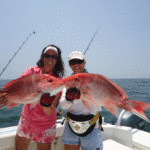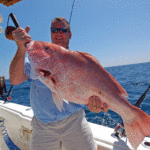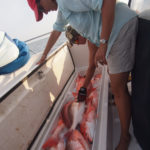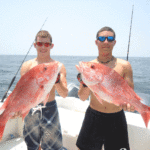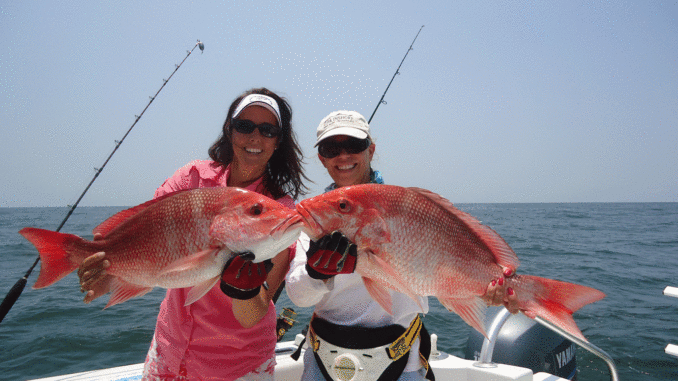
Anglers have been hoping the future for snapper would begin to clear, but the species still faces thunder clouds on the horizon.
It is your classic good-news/bad-news tale. The good news is there are more red snapper around the oil rigs in the northern Gulf of Mexico today than ever before, and they are much bigger than they have ever been. The bad news is the limit on red snapper remains at two per angler per day, and the season has been cut to just 49 days.
Daryl Carpenter, president of the Louisiana Charter Boat Association (who also owns and operates Reel Screamers Guide Service out of Grand Isle), is frustrated by the situation.
“They are projecting an even shorter season next year,” he said. “Red snapper is a staple of the offshore guide business. We go out hoping to find some big-game fish such as tuna and wahoo, but there are no guarantees.
“We always had red snapper to fall back on as we would head back home.”
Filling boxes
The ability to fill out their boxes with red snapper meant anglers could always justify the expense of the trip by bringing some food home. Without red snapper, it is hard for customers to justify the expense of an offshore trip, according to Carpenter.
“In my opinion, each of the states knows what is going on in their own waters,” said Carpenter. “We just need to get the feds out of our business.
“Florida has a problem as the result of long years of overfishing, but there is no shortage of red snapper in Louisiana waters.”
Shrimpers not the problem
Shrimpers are not part of the problem with red snapper, according to Carpenter, because of the reduction in the size of the fleet.
Cheap imported shrimp plus the high price of fuel has all but eliminated the by-catch problem shrimpers formerly caused for red snapper and many other fish.
“Right now we go for days without even seeing a shrimp boat out there,” he said. “The way it used to be, they were everywhere.”
But Carpenter believes government has grossly overreacted to problems with the Gulf fisheries. Now people are actually building ships with giant cranes and hoists that can pluck a rig out of the Gulf in just a few hours.
“Interestingly, the loss of habitat directly caused by these very foolish moves by the feds is not causing us a problem with the red snapper population,” said Carpenter. “As a matter of fact, the red snapper are so abundant, we have trouble catching other fish around the rigs.
“We pull up to a rig, and red snapper season is closed. So we are fishing for amberjack and mangrove snapper. But we can’t keep enough bait on the boat to handle all the red snapper constantly biting on our lines.”
Trolling for snapper?
Carpenter said the snapper are so plentiful, anglers are catching red snapper while trolling.
“I have been fishing all my life, and I never heard of that,” he said. “But I heard of it twice lately.
“That just tells you how many red snapper there are out there. Now you tell me: Why is the red snapper season going to be shorter next year?”
Carpenter said he is for throwing out the Magnuson Act and putting in state controls.
“This foolish federal regulation is hurting everyone’s pocketbook,” said Carpenter.
James Cowan, professor in the Department of Oceanography and Coastal Sciences at LSU, said there are reasons the season may be shorter next year.
“Well, we have been looking at the age structure of the snapper in the Gulf, and found that they are dominated by year classes 2004, 2005 and 2006,” said Cowan. “There have been no strong year classes since 2006.
“That means the red snapper everyone is catching are 6 to 8 years old. If we catch all of those, there may be no more.”
Red snapper are funny
Cowan explained that red snapper are funny creatures. They will inhabit the high-relief structures such as the rigs and reefs, and then they will move off and disperse to little hard spots in the Gulf. He explained that snapper live to 55 years of age, and they do not reach their full output until they are 12 to 15 years old.
“There is not enough escapement to allow the fish to get old enough to reach their true sexual maturity and maximum productivity,” he said. “We did not enjoy a strong year class in the early 1980s and the early 1990s, and that led to the worst condition we have ever seen when it came to the stock of red snapper in the Gulf. There are very few fish out there that are over 10 years of age, and that is the concern.
“We want to be sure of getting strong year classes in the future.”
Cowan said the scientists know what the fishermen are saying is true, but some of the fish will begin moving from the high-relief structures soon, and we will see a big decline in red snapper at the rigs once those three good year classes are gone.
Harry Blanchet, director of the Marine Fisheries Section in the Office of Fisheries at the Louisiana Department of Wildlife and Fisheries said the red snapper stock assessment shows quite clearly that the species is still overfished.
“The biomass spawning is less than optimal,” he said. “To keep the biomass at maximum sustainable yield, red snapper need an SPR (spawning potential ratio) of 26 or 27 percent, but what we have is seven percent.
“A few years ago, it was below three percent.”
Things are getting better, according to Blanchet. There are more fish in the water than there have been for the past 40 or 50 years, but what people are catching now are fish that weigh around 10 pounds. A few years ago, the average red snapper caught was 2 pounds, but today we are way above that because of good management practices.
“The simple fact is that we have twice the biomass since 1990-95, but we will have to triple what we have today before we can call the stock recovered,” he said. “The plan is to bring the SPR to 26 or 27 percent, but that is tough because red snapper are very easy to catch.”
New benchmark study needed
Blanchet said the information on red snapper is based on a benchmark study several years ago with the addition of new information, but the benchmark study needs to be done again.
“Everyone wants a new assessment,” he said. “What we are seeing right now is a hiccup. And we are playing it safe. There is a lot of new research that will be wrapped up in the next year or two, but we can’t do it in six months.
“Everyone liked the fall season last year, and that can probably be done again if we get a full assessment in 2012 or 2013 through the Gulf Council.”
Blanchet explained that redfish are a short-lived species that are mostly harvested at between one and three years of age. When they get to be five years old, they move offshore so the maximum size limit of one above 27 inches serves us well. That is because redfish are not in the fishery for very long.
Likewise, shrimp can be harvested hard and you will have the same numbers next year, but snapper are a long-lived species with a long recovery when they are overfished. The strongest contributors to the biomass are 10 pounds and up.
What about Rigs to Reefs?
Blanchet said more habitat just means more places to go and catch red snapper. The net benefit is doubtful because it just means more places where the fishermen can go and catch red snapper.
“It is not a simple story,” said Blanchet. “As the shrimp by-catch harvest has been reduced because of the cheap imports and high fuel prices, we need to recognize that in the stock assessment.
“But the rigs have to come out because the regulations on them were put in place by the Minerals Management Service, and those regulations go way back. But right now we are beginning to survey where the rigs are, and all of that information will be included in the new survey data.”
Bottom line, it does not look as though the red snapper mess will be cleared up for at least the next two or three years. After that, the scientists may have reason to lighten up on some of the restrictions. We may see a return of the fall season, but don’t bet on it happening next year.
